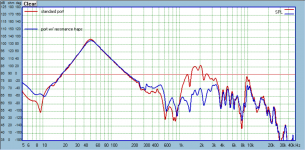Augerpro tested some port resonators, didn't work too well if I remember. However holes to relieve pressure nodes of port pipe harmonics work somewhat. Augerpro commented that some kind of chamber around the port to relieve to worked better (distortionwise) than just venting back to the main enclosure, with some damping material of course. That solution might also have some resonator thing going on.
For closed bass/mid enclosure this might work though, quarterwave resonators on the long ends damping modes that fall into pass band. Similar design like for the tweeter but perhaps only few chambers needed for those few lowest and problematic modes who fall on the pass band. One would have to care about impedance match, perhaps bigger box results etc. Perhaps just too complicated solution for most situations. Nice for tweeters apparently, but not sure if long wavelengths need this solution as there is possibility to crossover to smaller driver and box before issues, except with the tweeter.
For closed bass/mid enclosure this might work though, quarterwave resonators on the long ends damping modes that fall into pass band. Similar design like for the tweeter but perhaps only few chambers needed for those few lowest and problematic modes who fall on the pass band. One would have to care about impedance match, perhaps bigger box results etc. Perhaps just too complicated solution for most situations. Nice for tweeters apparently, but not sure if long wavelengths need this solution as there is possibility to crossover to smaller driver and box before issues, except with the tweeter.
Last edited:
This is the LS50 meta: https://www.stereophile.com/content/kef-ls50-meta-loudspeaker-measurements


Port output above tune does appear reduced compared to simlar speakers with 'standard' port designs: ( https://www.audiosciencereview.com/...kins-607-s2-anniversary-edition-review.21597/ )

Port output above tune does appear reduced compared to simlar speakers with 'standard' port designs: ( https://www.audiosciencereview.com/...kins-607-s2-anniversary-edition-review.21597/ )
tmuikko> actually all the ports where the resonances were damped well used resonant chambers.
What did not work very well is any damping material in the port, a resonator in the center of the port as by Polk, or my attempts at duplicating a Kef. I think the foam I used was pretty similar to theirs, but I wasn't too impressed. Here were the first results of port testing: https://www.diyaudio.com/community/...s-shootout-thread.356130/page-12#post-6411676 And the full journey: https://www.somasonus.net/box-construction-methods
What did not work very well is any damping material in the port, a resonator in the center of the port as by Polk, or my attempts at duplicating a Kef. I think the foam I used was pretty similar to theirs, but I wasn't too impressed. Here were the first results of port testing: https://www.diyaudio.com/community/...s-shootout-thread.356130/page-12#post-6411676 And the full journey: https://www.somasonus.net/box-construction-methods
I suppose so, resonant traps placed at 1/2 and 1/4 wavelength. I did try a chamber depth equal to 1/4 wavelength as he mentions, and is common in these sorts of traps, but it wasn't all that different in performance. Although my traps were pretty close to 1/4 wavelength already. I'm doing final checks right now, and that will include printing a larger port and see how things scale, chamber depth being one thing I need to focus on.
Gravebump: Been really interested in this topic lately, there are several scientific papers out, about subwavelength metadiffusors and meta-absorbers. ISignificantly. Like, orders of magnitude.
To achieve something comparable, you'd need something like the B&W nautilus design (sealed transmission line.)
Having said that, in my own home I use Bubos absorbers from Amazon. I 3D printed metamaterial absorbers, but a 8"x8" absorber takes 20 hours to print and costs about $10 worth of filament.
Bubos absorber is 12"x12" and costs like $3.
I have them in a hallway leading to a guest room, and it's weird how when you walk by them you can hear the ambient SPL fall by about 10dB. It's a trip.
I put them in there to basically turn the hallway into a black hole for sound, sort of like how Danley put tuned Helmholtz resonators in his first tapped horns, to null out the out-of-band peaks.
I'm not really afraid of long prints if I can get good absorption / diffusion in the low bass region, say 50-100hz with something that's less than 10-15cm deep. That's sort of the holy grail, so I'd like to figure out what's possible. I haven't sat down and tried to parse the math in most of these papers to parametrize designing panels, but a lot of it looks ... harder than any math I've done lately. Anyone managed to implement anything like this https://www.nature.com/articles/s41598-017-05710-5 or this? https://journals.aps.org/prx/abstract/10.1103/PhysRevX.7.021034
The skinny QRD thing is really interesting because even at 60hz we're only (supposedly) talking about something around a foot deep. That's almost doable on my $300 printer... and significantly more appealing than trying to build a QRD out of wood or whatever, even if it does take a week to print.
(related and possibly stupid question - can diffusion still happen in a room below the shroeder frequency?)
I suppose it can "happen", but might be inaudible, because Shroeder frequency is the point at which reverberation is no longer dominant and modal behaviour starts being dominant. The audibility of both drops and rises with frequency but at that specific point their contribution is equal. At least that's how I see it.
@digitalthor see this technote on optimal rear chambers for a similar idea applied to mid-ranges
Attachments
Has anyone tried this on midrange cabinets?
Metamaterials (which are actually set of 1/4 WL or Helmholtz resonator absorbers) are effective under the free field condition, while in a closed box the air compliance complicates the thing considerably.
- Home
- Loudspeakers
- Multi-Way
- 3D Printed Metamaterials


